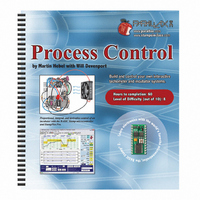122-28176 Parallax Inc, 122-28176 Datasheet - Page 12

122-28176
Manufacturer Part Number
122-28176
Description
GUIDE STUDENT PROCESS CONTROL
Manufacturer
Parallax Inc
Specifications of 122-28176
Accessory Type
Manual
Product
Microcontroller Accessories
Lead Free Status / RoHS Status
Contains lead / RoHS non-compliant
For Use With/related Products
Propeller Education (PE) Kit
Lead Free Status / RoHS Status
Lead free / RoHS Compliant, Contains lead / RoHS non-compliant
- Current page: 12 of 330
- Download datasheet (11Mb)
Page 2 · Process Control
A more sophisticated system would have a sensor to monitor temperature and provide
feedback to the controller. The controller would automatically adjust the actuator to
regulate the controlled parameter - temperature. The controller would drive the heating
system to maintain the temperature near the defined set point. An example of this is your
home heating system.
Consider the difference between how the cabin temperature of the automobile is
controlled versus the temperature in a home. In the automobile, the heat output is
variable but has no sensors that directly affect the heat output and maintain temperature.
In home heating a sensor is used to monitor the temperature, but the output of the heating
system is not variable; it is either on or off and cycles to maintain temperature in a
comfortable band. The controller itself may be very simple, such as a metallic coil that
expands and contracts, or more complex, such as a microcontroller similar to the BASIC
Stamp.
These are two very unique means of controlling a process. First, the types of drive
employed may be variable or on/off. Second, whether feedback from the system may or
may not be used in the control of the system.
INPUT, DRIVE AND MONITORING
Just as important as the type of control employed are the methods used for the input into
the controller. Will the inputs provide a simple on/off input to the controller? If using an
analog (variable level) input instead of a digital one (only two levels), how can it be
conditioned for on/off input if needed? If analog input is required, what are methods to
bring this data into the BASIC Stamp? How is the data represented in the BASIC Stamp
and how can it be converted to meaningful information?
In terms of the drive of a system, there are several questions as well. Do we need to
employ on/off control of the actuator, such as turning a heater or pump on or off? Does
the process require variable control of the drive such as regulating heat or flow output
between on or off? Does the process actuator require higher current or voltage than is
provided by the BASIC Stamp? How can the BASIC Stamp outputs be used to control
these actuators?
In industry, monitoring of systems is often required in order to ensure proper control
action and to determine response in order to adjust this control action.
Another
monitoring aspect is data logging, or being able to collect real time data from the system
for analysis.
Related parts for 122-28176
Image
Part Number
Description
Manufacturer
Datasheet
Request
R

Part Number:
Description:
MANUAL FOR SUMOBOT
Manufacturer:
Parallax Inc
Datasheet:

Part Number:
Description:
GUIDE STUDENT SMART SENSORS
Manufacturer:
Parallax Inc
Datasheet:

Part Number:
Description:
MANUAL PROPELLER
Manufacturer:
Parallax Inc
Datasheet:

Part Number:
Description:
LEAD WIRES FLYING CABLE III/IV
Manufacturer:
Xilinx Inc
Datasheet:

Part Number:
Description:
BOARD ADAPTER AND FLY LEADS
Manufacturer:
Xilinx Inc
Datasheet:

Part Number:
Description:
PLATFORM CABLE USB II
Manufacturer:
Xilinx Inc
Datasheet:

Part Number:
Description:
KIT STARTER COOLRUNNER-II BUNDLE
Manufacturer:
Xilinx Inc
Datasheet:

Part Number:
Description:
Microcontroller Modules & Accessories DISCONTINUED BY PARALLAX
Manufacturer:
Parallax Inc

Part Number:
Description:
Microcontroller Modules & Accessories DISCONTINUED BY PARALLAX
Manufacturer:
Parallax Inc

Part Number:
Description:
BOOK UNDERSTANDING SIGNALS
Manufacturer:
Parallax Inc
Datasheet:

Part Number:
Description:
BOARD EXPERIMENT+LCD NX-1000
Manufacturer:
Parallax Inc
Datasheet:

Part Number:
Description:
IC MCU 2K FLASH 50MHZ SO-18
Manufacturer:
Parallax Inc
Datasheet:












